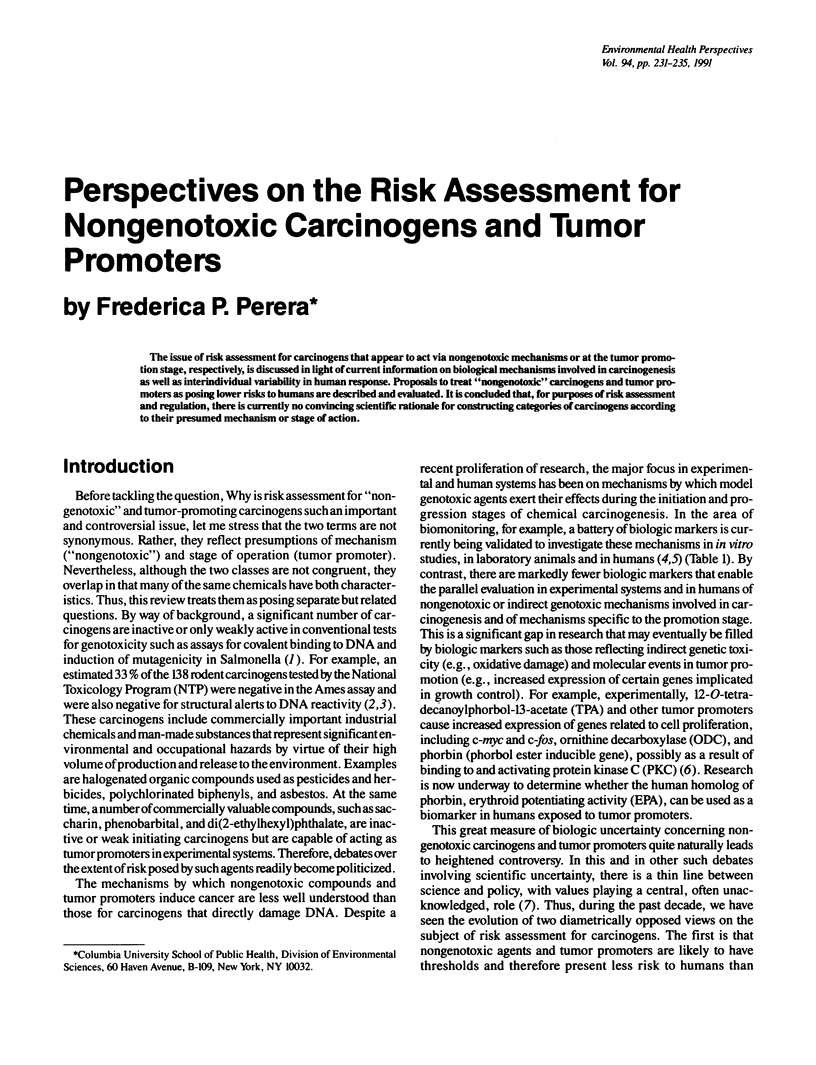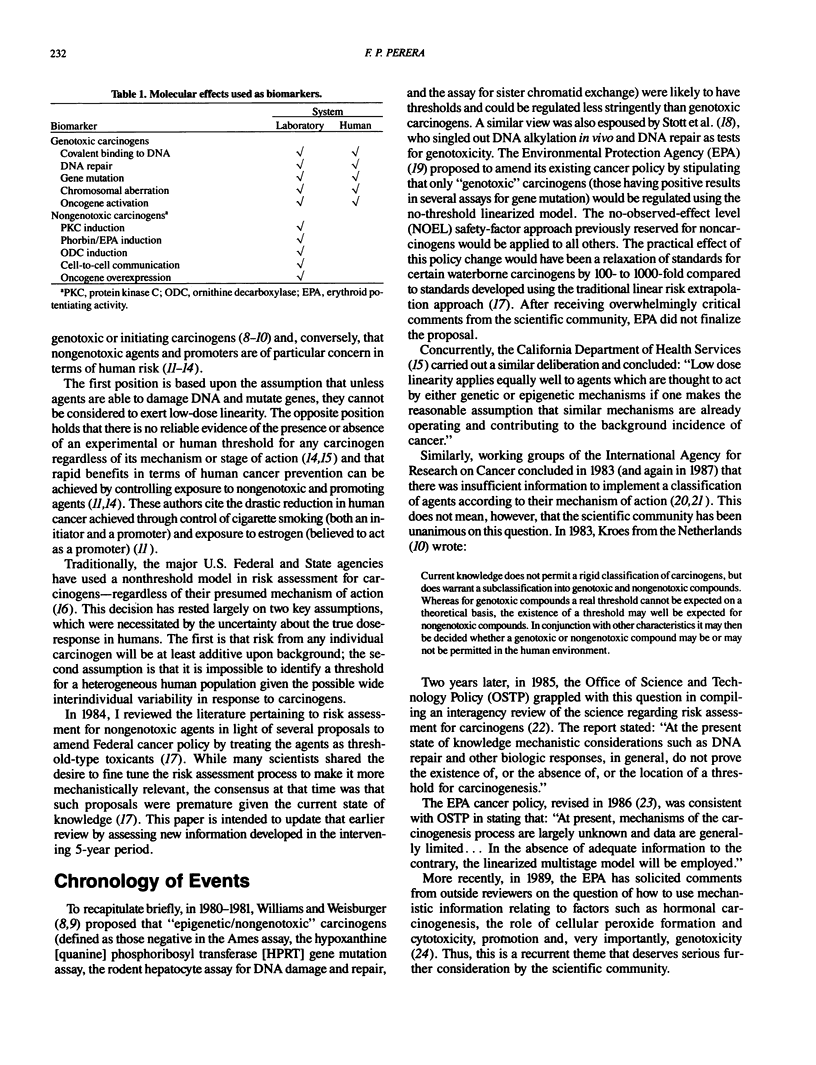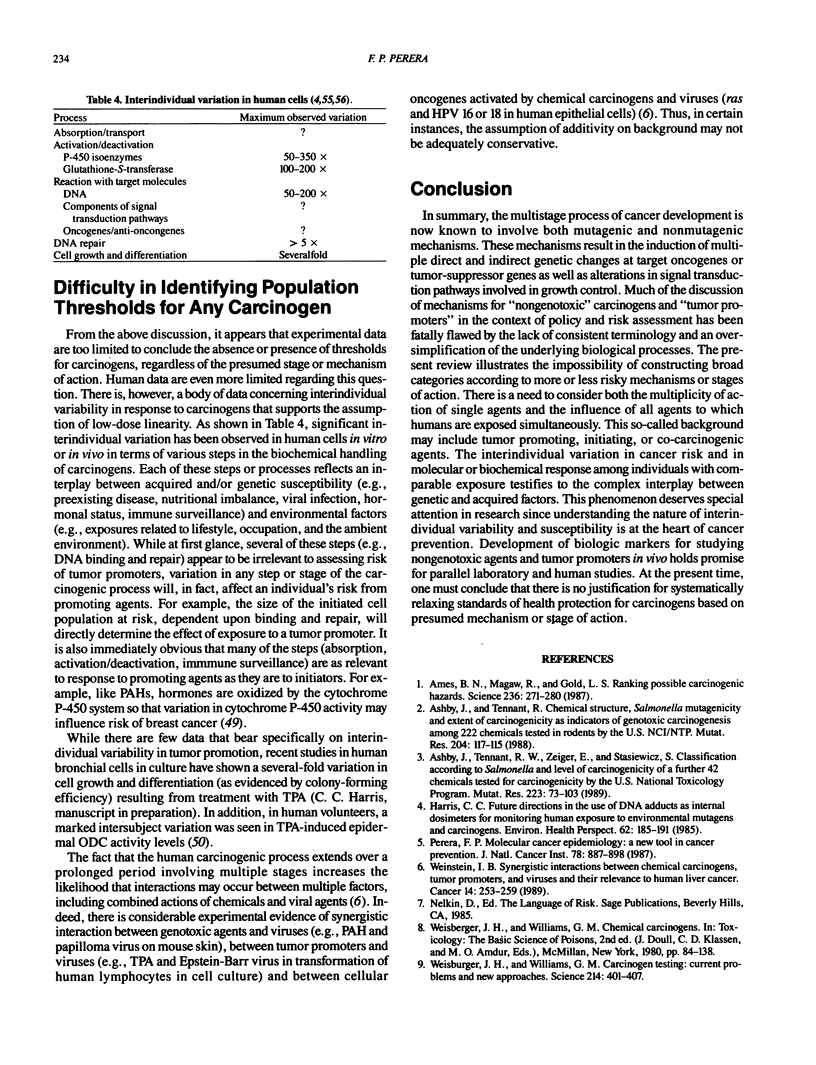Abstract
The issue of risk assessment for carcinogens that appear to act via nongenotoxic mechanisms or at the tumor promotion stage, respectively, is discussed in light of current information on biological mechanisms involved in carcinogenesis as well as interindividual variability in human response. Proposals to treat "nongenotoxic" carcinogens and tumor promoters as posing lower risks to humans are described and evaluated. It is concluded that, for purposes of risk assessment and regulation, there is currently no convincing scientific rationale for constructing categories of carcinogens according to their presumed mechanism or stage of action.
Full text
PDF




Selected References
These references are in PubMed. This may not be the complete list of references from this article.
- Ames B. N., Magaw R., Gold L. S. Ranking possible carcinogenic hazards. Science. 1987 Apr 17;236(4799):271–280. doi: 10.1126/science.3563506. [DOI] [PubMed] [Google Scholar]
- Ashby J., Tennant R. W. Chemical structure, Salmonella mutagenicity and extent of carcinogenicity as indicators of genotoxic carcinogenesis among 222 chemicals tested in rodents by the U.S. NCI/NTP. Mutat Res. 1988 Jan;204(1):17–115. doi: 10.1016/0165-1218(88)90114-0. [DOI] [PubMed] [Google Scholar]
- Ashby J., Tennant R. W., Zeiger E., Stasiewicz S. Classification according to chemical structure, mutagenicity to Salmonella and level of carcinogenicity of a further 42 chemicals tested for carcinogenicity by the U.S. National Toxicology Program. Mutat Res. 1989 Jun;223(2):73–103. doi: 10.1016/0165-1218(89)90037-2. [DOI] [PubMed] [Google Scholar]
- BOUTWELL R. K. SOME BIOLOGICAL ASPECTS OF SKIN CARCINOGENISIS. Prog Exp Tumor Res. 1964;4:207–250. doi: 10.1159/000385978. [DOI] [PubMed] [Google Scholar]
- Barrett J. C., Thomassen D. G., Hesterberg T. W. Role of gene and chromosomal mutations in cell transformation. Ann N Y Acad Sci. 1983;407:291–300. doi: 10.1111/j.1749-6632.1983.tb47834.x. [DOI] [PubMed] [Google Scholar]
- Barrett J. C., Wiseman R. W. Cellular and molecular mechanisms of multistep carcinogenesis: relevance to carcinogen risk assessment. Environ Health Perspect. 1987 Dec;76:65–70. doi: 10.1289/ehp.877665. [DOI] [PMC free article] [PubMed] [Google Scholar]
- Birnboim H. C. DNA strand breakage in human leukocytes exposed to a tumor promoter, phorbol myristate acetate. Science. 1982 Mar 5;215(4537):1247–1249. doi: 10.1126/science.6276978. [DOI] [PubMed] [Google Scholar]
- Burns F., Albert R., Altshuler B., Morris E. Approach to risk assessment for genotoxic carcinogens based on data from the mouse skin initiation-promotion model. Environ Health Perspect. 1983 Apr;50:309–320. doi: 10.1289/ehp.8350309. [DOI] [PMC free article] [PubMed] [Google Scholar]
- Carcinogen policy at EPA. Science. 1983 Feb 18;219(4586):794–798. [PubMed] [Google Scholar]
- Cerutti P. A. Prooxidant states and tumor promotion. Science. 1985 Jan 25;227(4685):375–381. doi: 10.1126/science.2981433. [DOI] [PubMed] [Google Scholar]
- Day N. E., Brown C. C. Multistage models and primary prevention of cancer. J Natl Cancer Inst. 1980 Apr;64(4):977–989. [PubMed] [Google Scholar]
- Emerit I., Cerutti P. A. Tumour promoter phorbol-12-myristate-13-acetate induces chromosomal damage via indirect action. Nature. 1981 Sep 10;293(5828):144–146. doi: 10.1038/293144a0. [DOI] [PubMed] [Google Scholar]
- Frenkel K., Chrzan K. Hydrogen peroxide formation and DNA base modification by tumor promoter-activated polymorphonuclear leukocytes. Carcinogenesis. 1987 Mar;8(3):455–460. doi: 10.1093/carcin/8.3.455. [DOI] [PubMed] [Google Scholar]
- Frenkel K. Oxidation of DNA bases by tumor promoter-activated processes. Environ Health Perspect. 1989 May;81:45–54. doi: 10.1289/ehp.898145. [DOI] [PMC free article] [PubMed] [Google Scholar]
- Fürstenberger G., Kinzel V., Schwarz M., Marks F. Partial inversion of the initiation-promotion sequence of multistage tumorigenesis in the skin of NMRI mice. Science. 1985 Oct 4;230(4721):76–78. doi: 10.1126/science.3929385. [DOI] [PubMed] [Google Scholar]
- Fürstenberger G., Sorg B., Marks F. Tumor promotion by phorbol esters in skin: evidence for a memory effect. Science. 1983 Apr 1;220(4592):89–91. doi: 10.1126/science.6828884. [DOI] [PubMed] [Google Scholar]
- Harris C. C. Future directions in the use of DNA adducts as internal dosimeters for monitoring human exposure to environmental mutagens and carcinogens. Environ Health Perspect. 1985 Oct;62:185–191. doi: 10.1289/ehp.8562185. [DOI] [PMC free article] [PubMed] [Google Scholar]
- Ivanovic V., Weinstein I. B. Benzo[a]pyrene and other inducers of cytochrome P1-450 inhibit binding of epidermal growth factor to cell surface receptors. Carcinogenesis. 1982;3(5):505–510. doi: 10.1093/carcin/3.5.505. [DOI] [PubMed] [Google Scholar]
- Kroes R. Short-term tests in the framework of carcinogen risk assessment to man. Ann N Y Acad Sci. 1983;407:398–408. doi: 10.1111/j.1749-6632.1983.tb47846.x. [DOI] [PubMed] [Google Scholar]
- Loprinzi C. L., Verma A. K., Boutwell R. K., Carbone P. P. Inhibition of phorbol ester--induced human epidermal ornithine decarboxylase activity by oral compounds: a possible role in human chemoprevention studies. J Clin Oncol. 1985 Jun;3(6):751–757. doi: 10.1200/JCO.1985.3.6.751. [DOI] [PubMed] [Google Scholar]
- Pelling J. C., Slaga T. J. Cellular mechanisms for tumor promotion and enhancement. Carcinog Compr Surv. 1985;8:369–393. [PubMed] [Google Scholar]
- Perera F. P. Molecular cancer epidemiology: a new tool in cancer prevention. J Natl Cancer Inst. 1987 May;78(5):887–898. [PubMed] [Google Scholar]
- Perera F. P. The genotoxic/epigenetic distinction: relevance to cancer policy. Environ Res. 1984 Jun;34(1):175–191. doi: 10.1016/0013-9351(84)90087-2. [DOI] [PubMed] [Google Scholar]
- Perera F., Mayer J., Santella R. M., Brenner D., Jeffrey A., Latriano L., Smith S., Warburton D., Young T. L., Tsai W. Y. Biologic markers in risk assessment for environmental carcinogens. Environ Health Perspect. 1991 Jan;90:247–254. doi: 10.1289/ehp.90-1519502. [DOI] [PMC free article] [PubMed] [Google Scholar]
- Rabello M. N., Dealmeida W. F., Pigati P., Ungaro M. T., Murata T., Perira C. A., Beçak W. Cytogenetic study on individuals occupationally exposed to DDT. Mutat Res. 1975 Jun;28(3):449–454. doi: 10.1016/0027-5107(75)90238-9. [DOI] [PubMed] [Google Scholar]
- Reynolds S. H., Stowers S. J., Maronpot R. R., Anderson M. W., Aaronson S. A. Detection and identification of activated oncogenes in spontaneously occurring benign and malignant hepatocellular tumors of the B6C3F1 mouse. Proc Natl Acad Sci U S A. 1986 Jan;83(1):33–37. doi: 10.1073/pnas.83.1.33. [DOI] [PMC free article] [PubMed] [Google Scholar]
- Reynolds S. H., Stowers S. J., Patterson R. M., Maronpot R. R., Aaronson S. A., Anderson M. W. Activated oncogenes in B6C3F1 mouse liver tumors: implications for risk assessment. Science. 1987 Sep 11;237(4820):1309–1316. doi: 10.1126/science.3629242. [DOI] [PubMed] [Google Scholar]
- Slaga T. J., Butler A. P. Cellular and biochemical changes during multistage skin tumor promotion. Princess Takamatsu Symp. 1983;14:291–301. [PubMed] [Google Scholar]
- Stott W. T., Reitz R. H., Schumann A. M., Watanabe P. G. Genetic and nongenetic events in neoplasia. Food Cosmet Toxicol. 1981 Oct;19(5):567–576. doi: 10.1016/0015-6264(81)90507-1. [DOI] [PubMed] [Google Scholar]
- Van Duuren B. L., Sivak A., Segal A., Seidman I., Katz C. Dose-response studies with a pure tumor-promoting agent, phorbol myristate acetate. Cancer Res. 1973 Sep;33(9):2166–2172. [PubMed] [Google Scholar]
- Waters M. D., Stack H. F., Brady A. L., Lohman P. H., Haroun L., Vainio H. Use of computerized data listings and activity profiles of genetic and related effects in the review of 195 compounds. Mutat Res. 1988 May-Aug;205(1-4):295–312. doi: 10.1016/0165-1218(88)90024-9. [DOI] [PubMed] [Google Scholar]
- Weinstein I. B. Synergistic interactions between chemical carcinogens, tumor promoters, and viruses and their relevance to human liver cancer. Cancer Detect Prev. 1989;14(2):253–259. [PubMed] [Google Scholar]
- Weinstein I. B. The origins of human cancer: molecular mechanisms of carcinogenesis and their implications for cancer prevention and treatment--twenty-seventh G.H.A. Clowes memorial award lecture. Cancer Res. 1988 Aug 1;48(15):4135–4143. [PubMed] [Google Scholar]
- Yamasaki H. Multistage carcinogenesis: implications for risk estimation. Cancer Metastasis Rev. 1988 Apr;7(1):5–18. doi: 10.1007/BF00048275. [DOI] [PubMed] [Google Scholar]
- Yamasaki H. Tumor promotion--mechanisms and implication to risk estimation. Acta Pharmacol Toxicol (Copenh) 1984;55 (Suppl 2):89–106. doi: 10.1111/j.1600-0773.1984.tb02484.x. [DOI] [PubMed] [Google Scholar]
- Yuspa S. H., Poirier M. C. Chemical carcinogenesis: from animal models to molecular models in one decade. Adv Cancer Res. 1988;50:25–70. doi: 10.1016/s0065-230x(08)60434-0. [DOI] [PubMed] [Google Scholar]


